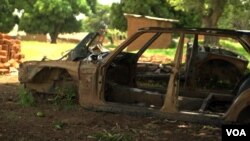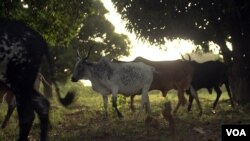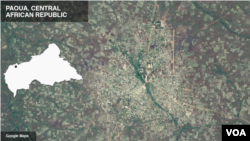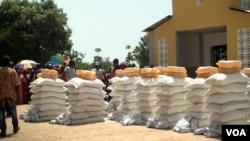Resurging violence in the Central African Republic has left full villages emptied and destroyed. The burned out houses are charred, with their thatched roofs totally gone. Inside the homes, evidence of a left-behind life is scattered throughout in the ashes: pots, pans, and bicycle frames. Other homes are looted with the doors kicked in and papers torn up.
Aid workers here warn that the country may be sliding back into conflict. More than 100,000 people have fled their homes since September.
In the north, predominantly Christian anti-balaka rebels used the village of Bambara as a base. But after the soldiers stole some cows from nearby nomadic people, an ex-Seleka militia came for revenge, killing about 25 people and burning more than 600 houses.
Alexi Finicule’s older brother was killed in the fighting and his house was burned down.
“My father died of old age,” he said, while standing next to the rubble remains of his home. “But when my big brother was killed, I was very shocked by that. I will always remember what happened here.”
Finicule, 38, was shot at by the ex-Seleka. A bullet grazed his skin, leaving a scar on his back. He fled to the bush to hide from the militia.
Now back in Bambara, Finicule received a kit from the U.N.’s International Organization of Migration to rebuild his house but his family doesn’t want to live in the same house where their family member was killed.
Major setback
The violence recalls the fighting and communal clashes that plunged the country into chaos nearly four years ago. Aid workers say the renewed violence has been a major setback.
“They don’t have food. They don’t have seeds. They don’t have mats to sleep on. They don’t have potable water,” explained I.O.M. operations assistant Fabrice Tiro. “So, everything was destroyed in these events. They are starting from zero.”
At another nearby burned out home, Apaulinere Horouro explained how even the town’s school was burned to the ground so his kids can’t attend.
“We don’t have anything,” Horouro said.
Meanwhile, at an internally displaced persons camp in nearby Ndim, a group of displaced ethnic Peul have been displaced twice due to fighting over the past few months.
“The future for us is truly in the hands of God,” said Alazi Makouri, the village chief, sitting on a tree-trunk bench. “Because, the population of the nearby village are the ones protecting us. We don’t have any say in the matter.”
The village chief said his people were attacked by the anti-balaka, who stole about 150 of their cows. They moved to the edge of the village and started growing maize and manioc. But, they were attacked again and finally sought refuge farther away at this camp.
Cows from other nomadic people passing through the area wander through the camp. With mangos in season at the moment, children collect the bright orange and yellow fruit from the ground in the camp. They live in tents constructed with wood and UN tarps.
A fifth of the country’s population is displaced — more than 400,000 people.
Medical needs
Doctors without Borders said civilians are being attacked in the country at levels not seen in years. The “spiraling” violence has left civilians “trapped in the crossfire, kicked out of their homes and cut off from their fields and livelihoods,” according to a MSF press release.
The non-profit medical organization supports a hospital in Paoua in the northwest of the country. The project coordinator at the hospital said MSF continues to struggle to access remote areas in need.
“Central African [Republic] is one of the poorest countries in the world and needs to be supported but the people are focusing on the conflict,” said Abdel Kader Tlidjane of MSF. “But it takes time for people to solve it. During this time we should be able to carry on with normal activities to give this access and it’s not easy.”
The biggest problem at the Paoua hospital is malaria, although they also treat war-wounded people.
Following the 2013-2014 crisis that left thousands dead, more than half of the population relies on humanitarian aid.
Humanitarian funding
Despite the increasing needs, humanitarian funding for the year for the country is at only 10 percent. UN officials told VOA the “disastrous” lack of support hurts the possibility of peace.
“Otherwise we are just feed the ground of armed groups who would just come back to the population and tell them, ‘Look the international community, they don’t care. The UN, they don’t care. Look you don’t even have food on your table. You don’t even schools for your kids," explained Najat Rochdi, the UN humanitarian coordinator for C.A.R. “So we also need to fight against that.”
WFP was forced to cut its food aid from 700,000 people last year to 400,000 people this year.
Total yearly funding for C.A.R. dropped from 68 percent to 37 percent over the past two years.












